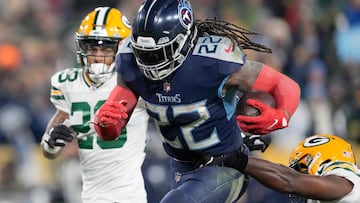When is the NFL trade deadline? Rules, eligibility, rumors, players, etc.
We have reached the National Football League trade deadline as October comes to a close. Let’s review what this means for the players and the teams.

As Halloween traditions move into the Día de los Muertos, so too do we see Monday Night Football bring Week 8 of the National Football League to a close. Fans across the United States and far beyond will be assessing how their team is doing -- whether an actual city franchise or a motley Fantasy Football mash-up -- and it also means that the trade deadline is here.
The Buffalo Bills and Tennessee Titans are reportedly in conversations regarding a trade that would send All-Pro running back Derrick Henry to Buffalo in exchange for a day-two draft pick.
When is the 2023 NFL trade deadline, and how does it work?
The trade deadline is October 31, at 4 p.m. ET, on the back of Week 8. Just like in the game, there are several rules the NFL has regarding trades. The rules are between the NFLPA and the franchise owners and are governed by a collective bargaining agreement (CBA). There are five categories to a player’s rights: trade eligibility, trade procedure, trade limitations, waivers, and transfer.
Trade eligibility
Any player can have his contract given to another team via trade at any point. This rule stands unless the player’s agent has put a no-trade clause in his contract under the special provisions. If a team wants to trade with a player with a no-trace provision, the player himself will have to agree to it. An example of someone who had that experience last year is the 49ers quarterback, Jimmy Garoppolo, who is playing for the Raiders this season.
Trade procedure
If two teams agree to trade a player with a no-trade provision, then that player’s team must have the player’s and agent’s written permission. The player can choose to forego his no-trade clause and accept or deny the trade based on the provision.
Trade limitations
There was a rule in place until 2020 that encouraged competitive balance and kept the best teams from continuing to get the best players. That rule was removed. Now, the two teams participating in a trade must understand how a salary-cap issue affects teams.
Waivers
A player may be waived by his team if he is not performing well. If he is waived between February 1 and the trade deadline, the player is a free agent and can negotiate a contract with any other team. On the other hand, if the team waives the player after the trade deadline, then that player is subject to the waiver claim process, which grants them additional rights based on whether they have a no-trade clause or not. The waivers go in reverse order of NFL standings.
If the player has a no-trade provision, he can become an unrestricted free agent immediately following that season. If he does not have a no-trade provision, he can become a free agent following the subsequent season. If that player is signed only through the current season, he can declare for free agency immediately following the season.
Transfer
If a player is traded to another team, his salaries, rights, obligations, and special provisions must transfer to the new team as well. That means any compensation paid to the player on their current contract must continue to be paid by the new team.
NFL trade deadline: key done deals
- Buffalo Bills add RB Derick Henry from Tennessee
- Kansas City Chiefs add WR Mecole Hardman from New York Jets
- San Francisco 49ers CB Donte Jackson from the Carolina Panthers
NFL trade deadline: rumors
At the time of writing, the following players and teams could still end up parting company in the final hours:
- Terrace Marshall Jr., WR, Carolina Panthers
- Courtland Sutton, WR, Denver Broncos
- Saquon Barkley, RB, New York Giants
- Montez Sweat, Edge, Washington Commanders





